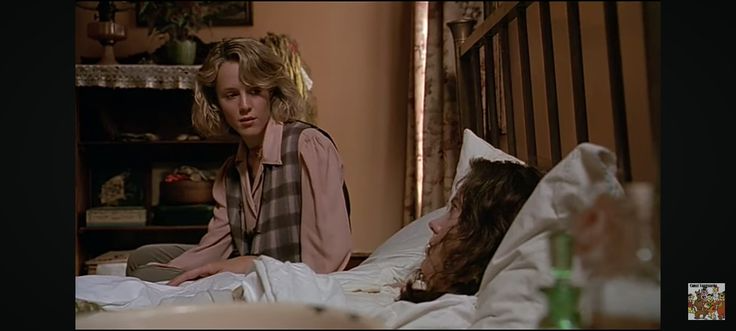
At first glance, Fried Green Tomatoes (1991) feels like a cozy, nostalgic film about friendship, small-town life, and the power of memory. Set against the backdrop of the gentle, sun-drenched South, it offers plates of comfort food, cheerful camaraderie, and heartfelt conversations.
But beneath this warm exterior, the film carefully weaves in deep, painful themes — particularly domestic abuse and systemic racism — without ever losing its tone of hope and resilience. This delicate balancing act is one of the film’s greatest artistic achievements.
Domestic Abuse: Ruth’s Silent Battle
One of the core storylines involves Ruth Jamison’s marriage to Frank Bennett, a relationship marked by emotional and physical violence.
The film doesn’t exploit Ruth’s suffering for drama; instead, it shows the effects of abuse with subtlety and respect:
-
Ruth’s body language around Frank is fearful and closed-off.
-
Frank’s cruelty is clear in short, sharp scenes that don’t linger unnecessarily, emphasizing the terror without making the audience feel voyeuristic.
-
Ruth’s rescue by Idgie is portrayed as an act of love and bravery, not just rebellion.
By showing how Ruth struggles to reclaim her life — and how much help she needs to escape — Fried Green Tomatoes addresses domestic violence without turning Ruth into a “damsel in distress.”
Instead, community support, particularly from women like Idgie, Sipsey, and the Threadgoode family, becomes her salvation.
Importantly, the film highlights that legal systems of the time offered little protection to women like Ruth. She couldn’t simply divorce Frank or call the police. In many ways, the people of Whistle Stop are forced to create their own form of justice.

Racism and Survival in the South
The film is also clear-eyed about racism — particularly through the experiences of Sipsey and Big George:
-
Sipsey, a Black woman working for the Threadgoode family, navigates a world where she must be careful about how she speaks and acts in public.
-
Big George, Sipsey’s son, faces false accusations of murder simply because of his race when Frank disappears.
-
Law enforcement in the story is portrayed as biased and unjust, ready to punish a Black man with little or no evidence.
Despite the film’s otherwise gentle tone, these realities are never sugarcoated.
The white characters like Idgie recognize (at least partially) the dangers their Black friends face — and work quietly to protect and defend them. But even with solidarity, the risks are ever-present.
By threading these truths into the story, Fried Green Tomatoes acknowledges the deep racial inequalities of the early 20th-century South without losing its emotional warmth.
Rather than focusing on anger or despair, the film shows resilience: how marginalized people found ways to survive, build community, and protect one another.
A Safe Haven: The Whistle Stop Café as a Symbol
The Whistle Stop Café, run by Idgie, Ruth, Sipsey, and Big George, becomes more than just a restaurant — it is a symbol of resistance and healing:
-
A place where race, gender, and class barriers are softened, if not erased completely.
-
A space where the abused find safety, where the oppressed find dignity, and where outsiders are welcomed.
In this small café, the characters create a microcosm of a better world — one where kindness, loyalty, and mutual support matter more than societal rules.
The café’s importance is shown not just through food, but through the relationships built there.
Even as the outside world remains harsh and unjust, the Whistle Stop Café represents what community can accomplish when people choose compassion over prejudice.
Storytelling Choices: Why It Works
Director Jon Avnet and screenwriters Fannie Flagg (also the author of the original novel) and Carol Sobieski made crucial storytelling choices that allow heavy themes to blend with warmth:
-
Tonal Shifts Are Handled Gently: Moments of joy and humor are placed between serious scenes, helping the audience process heavy content without feeling overwhelmed.
-
No Trauma Porn: The film avoids graphic depictions of violence. Instead, it focuses on the emotional aftermath and the fight for recovery.
-
Focus on Human Dignity: Even when characters suffer, the story centers their dignity, strength, and agency — never reducing them to mere victims.
By doing so, Fried Green Tomatoes creates a film that is hopeful without being naive, and truthful without being brutal.
Bittersweet, Honest, and Ultimately Uplifting
Fried Green Tomatoes reminds us that even in the darkest times — amidst violence, loss, and injustice — people can build spaces of kindness and courage.
The film’s true magic lies in its honest acknowledgment of pain while refusing to let that pain define its characters’ entire lives.
It’s a movie about survival, not just endurance — about growing something sweet and nourishing, even from the bitterest experiences.
In a world that often prefers to either sanitize history or drown it in misery, Fried Green Tomatoes offers a rare and beautiful third path:
a story of hard truths wrapped in hope.
